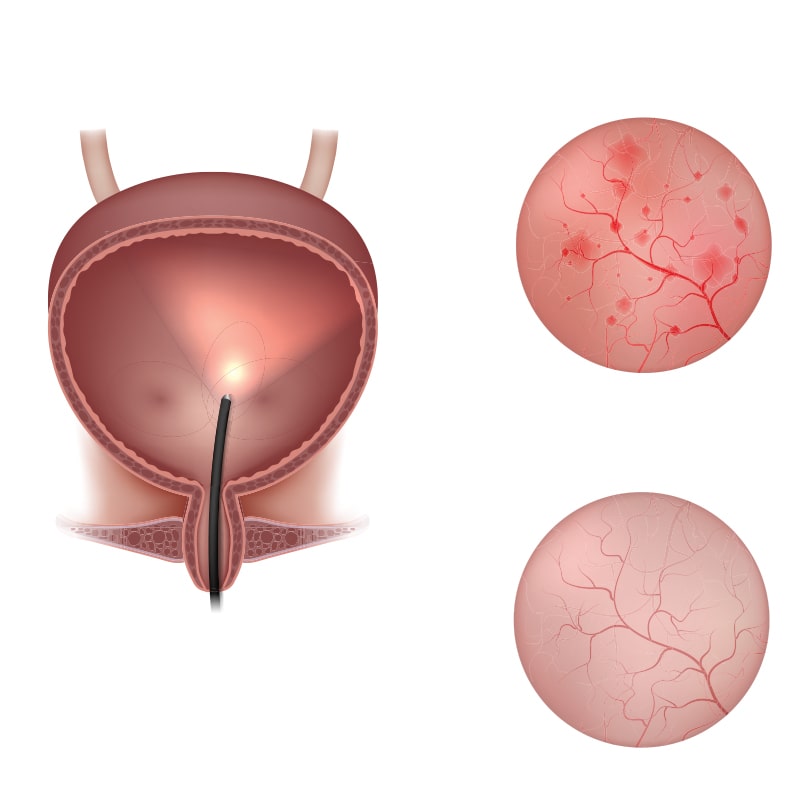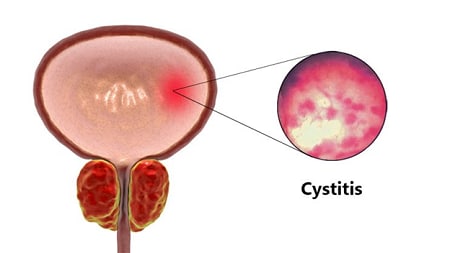Cystitis is a urinary bladder disease. When there is irritation, redness, or swelling in the bladder, the walls of the bladder get inflamed and cause cystitis. This may be caused due to urinary tract infection (UTI) or any bacterial infection.
There are many causes of cystitis, like half-empty bladder, insertive devices, menopause, etc. frequent urination, cloudy or smelly urine, and fever are some of the symptoms of this disease. This can be treated by using antibiotics, but if left untreated, it can cause complications. Some of the common complications are blood in urine and infection in the kidneys, which may damage your kidneys permanently.
Overview on Cystitis

What are the Cystitis Causes?
Now that you know what cystitis is, let us understand the cystitis causes. Most of the cases occur when bacteria enter the bladder from external genito-urinary parts. The major causes behind this could be the following:
1. Insertive devices
Long-term tampon use, insertion of a urinary catheter, or the usage of a spermicidal diaphragm for birth control in women can lead to increased bacterial exposure to the bladder along the urinary tract.
2. Sexual activity
Frequent or vigorous sexual activity is responsible for higher risk of contracting cystitis in women.
3. Half-empty bladder
Pregnant women and men with an enlarged prostate may experience difficulty emptying the bladder. This results in the growth of bacteria along the urinary tract. A blockage in the urinary system could also disrupt the free flow of urine.
4. Menopause
The lining of the urethra becomes thinner due to low estrogen levels in women of menopausal age. This coupled with the reduced production of mucus in the vagina, which is responsible for a reduction in bacterial growth, makes them more susceptible to cystitis symptoms.
5. Radiation
Late radiation cystitis is a condition that is caused due to radiation treatments which may result in damage to the bladder.
What are the Cystitis Symptoms?
Some of the cystitis symptoms that are seen commonly are:
Frequent Urination - And urge to urinate frequently, in most cases even after the bladder has been emptied
Unusual Urination - Urine that is either cloudy, has a strong smell or may have blood
Bladder Pressure - A sensation of pressure on the bladder implying that it is full
Feeling feverish
UTI - Having a urinary tract infection(UTI)
Pain during intercourse - Painful experienced during sexual intercourse
Cramps - Cramps in the back or abdomen
If the above cystitis symptoms are left unnoticed, the infection is likely to spread from the bladder to the kidneys and be a health risk. You may experience nausea, vomiting, chills, and pain in the back. If this is accompanied by fever and the appearance of blood in the urine, you should immediately seek medical attention.

About Cystitis Diagnosis
When you visit a doctor with cystitis symptoms, you may be asked for a urine sample to know the exact cause. Depending on the bacteria responsible for the infection as revealed in the urine culture, you may accordingly be prescribed antibiotics. Additionally, the doctor may also use a cystoscope to inspect your bladder closely.
It consists of a thin tube with a camera and light attached at one end. In some cases, a small tissue sample might be taken for further inspection. Imaging tests such as an X-ray or ultrasound may also be conducted to eliminate any structural abnormalities such as a tumour.
Cystitis Treatment: How to Get Rid of the Disease
Mild cystitis symptoms resolve by themselves within a few days. However, if they persist beyond four days, you should consult a physician who would prescribe a course of antibiotics for cystitis treatment. Taking a dose of antibiotics will resolve symptoms of both bacterial and Interstitial cystitis. In case, you are diagnosed with a chronic case along with underlying structural issues, surgery may be required.
Bacterial Cystitis Treatment
First-time infection
After the antibiotic treatment, symptoms often improve significantly within a day or so. Irrespective of the length of the treatment, it is vital to take an entire course of antibiotics that are prescribed by your doctor.
Repeat infection
In case of recurring UTIs, you may be recommended a longer antibiotic treatment or may be referred to a urologist for a diagnosis, to see if the cause of the infection is urologic abnormalities.
Hospital-acquired infection
Hospital-acquired bladder infections could be challenging to treat because bacteria found in hospitals are often resistant to the common types of antibiotics. This is why different types of antibiotics and different treatment approaches may be needed.
Interstitial Cystitis Treatment
In the case of interstitial cystitis, the cause of inflammation is uncertain resulting in no single treatment that works best.
Procedures used to reduce the signs and symptoms of interstitial cystitis include the following:
Medications that are taken orally or inserted directly into your bladder
Procedures manipulating your bladder to improve symptoms, which include bladder distention or surgery
Nerve stimulation that uses mild electrical pulses to reduce the frequency of urination or relieve pelvic pain
Some Cystitis Home Remedies to Ease Discomfort
If your cystitis symptoms are mild, you can make use of the following remedies at home, such as:
Use Heating pads
Place a heating pad on your abdomen or back for relief from cramping.
Take a painkiller
If the pain is unbearable, you can take an over-the-counter analgesic to relieve it.
Taking a Sitz bath
Sit in warm, shallow water up to your hips to soothe irritation in the pelvic area.
Along with the prescribed antibiotics for your cystitis treatment, you can also follow some tips that can help you manage your condition at home. These include:
Regular fluid intake
Drinking fluids such as water and cranberry juice can keep your bladder healthy and help ease cystitis symptoms.
Breathable, loose clothes
Remember to wear clothes that are not too tight, but comfortable. Prefer cotton undergarments to prevent further aggravation of cystitis.
When Should I See a Doctor for Cystitis?
You should immediately seek a doctor’s consultation if you have any cystitis symptoms like back pain, fever and chills, nausea and vomiting, etc. If you notice blood in your urine or start getting frequent, painful urination and if these symptoms last for hours, you should seek immediate medical help.
The doctor’s consultation will be required if your cystitis symptoms return after finishing the course of antibiotics. In the case of children, if they start having daytime wetting accidents, you should consult a paediatrician. Cystitis is rare in healthy men, so if you have any symptoms like these, you should get them checked.
Cystitis Complications
If treated properly and in time, cystitis rarely leads to any complications. However, if left untreated, there is a possibility that it can lead to some serious complications. Some of these cystitis complications may include:
Infection in the Kidney:
If you leave the bladder infection untreated, it can cause kidney infection that is also known as pyelonephritis. Such an infection may permanently damage your kidneys. Young children and older adults are at a greater risk as their symptoms are often overlooked or mistaken for other conditions as well.
Blood in Urine:
You may have blood cells in your urine that won’t be visible to the naked eye and can be only seen under a microscope. This usually resolves with cystitis treatment. If the blood cells still remain after cystitis treatment, the doctor will recommend a specialist to determine the cause. The visible blood in urine is rare in typical bacterial cystitis. However, it is more common with chemotherapy or radiation-induced cystitis.
How to Prevent Cystitis?
While you cannot prevent cystitis, certain precautions such as those below can help you avoid it:
Practice safe sex
Good hygiene practices during sexual activity as well as the use of a lubricant can reduce your chances of getting an infection.
Choose your toiletries carefully
If your skin is sensitive, use an unperfumed soap or liquid wash to clean your genital area.
Empty bladder
Do not delay the urge to urinate and remember to empty the bladder completely during urination.
Loose clothing
Avoid wearing tight-fitting clothes and underwear. Prefer breathable fabrics such as cotton undergarments.
Toilet hygiene
Remember to wipe from front to back in the toilet to reduce the risk of developing a bladder infection.
While women get more cystitis infections as compared to men, cystitis in men can be a health risk if left untreated, leading to kidney or prostate infection. Diagnosis of cystitis in men is more often the result of an underlying condition, such as a tumour, infection of the prostate, blockage, or an enlarged prostate.
Even though prevention is better than cure, you should always stay safe. You can take care of any unplanned medical emergencies by opting for a good health insurance plan available at Bajaj Markets.
Conclusion
Cystitis symptoms usually tend to resolve by themselves. When cystitis is spotted early, it can be controlled with medications and home remedies. However, delaying cystitis treatment can aggravate your situation. Apart from cystitis, several chronic medical conditions can throw your life out of gear upon diagnosis. Some of these may exhaust your savings and leave you financially drained. Therefore, it is advised to be prepared for such health uncertainties with the right financial back up - health insurance. So don’t wait more and choose from a wide range of health insurance options at Bajaj Markets.
Health Insurance Plans Available at Bajaj Markets
Health Insurance Top Pages
- Health Insurance
- Types Of Health Insurance
- Care Health Insurance
- Aditya Birla Health Insurance
- Bajaj Allianz Health Insurance
- Mediclaim Policy
- Best Health Insurance Companies in India
- Senior Citizen Health Insurance
- Family Health Insurance
- Health Insurance For Parents
- Health Insurance Premium Calculator
- Group Health Insurance
- Maternity Insurance
- Top Up Health Insurance
- Senior Citizen Mediclaim Policy
- Individual Health Insurance
- Comprehensive Health Insurance
- Health Insurance For Women
- Commercial Health Insurance
- Long Term Health Insurance
- Child Health Insurance
- Short Term Health Insurance
- Critical Illness Health Insurance
- Benefits Of Health Insurance
- Mental Health Insurance
- Compare Health Insurance
- 1 Lakh Health Insurance
- 3 Lakh Health Insurance
- 5 Lakh Health Insurance
- 50 Lakh Health Insurance
- Aditya Birla Activ Assure Diamond Plan
- Aditya Birla Health Insurance Renewal
- Bajaj Allianz Extra Care Plus
- Bajaj Allianz Health Guard
- Bajaj Allianz Health Insurance Renewal
- Cancer Insurance
- Cashless Health Insurance
- Coinsurance
- Health Insurance Tax Benefits
- Copay
- Employee Health Scheme
- Health Insurance Card
- Health Insurance Claim Settlement Ratio
- Health Insurance Claims Process
- Health Insurance For Heart Patients
- Health Insurance On Emi
- Health Insurance Renewal
- Health Insurance With Opd Cover
- No Claim Bonus
Government Health Insurance Schemes
- PMJAY
- Swasthya Sathi
- CGHS
- National Urban Health Mission
- PMSBY
- Swasthya Sathi Card
- Janani Suraksha Yojana
- National Immunization Schedule
- RBSK
- Ayushman Bharat Registration
- NRHM
- CMCHIS
- Dr Ysr Aarogyasri
- Mission Indradhanush
- West Bengal Health Scheme
- BIS Portal
- Rashtriya Swasthya Bima Yojana
- Ayushman Bharat Digital Mission
- Pradhan Mantri Swasthya Suraksha Yojana
- PMSMA
- Biju Swasthya Kalyan Yojana
- PMMVY Scheme
- Mahatma Jyotiba Phule Jan Arogya Yojana
- Arogya Sanjeevani Policy
- Pmjay Hospital List
- Chief Minister Comprehensive Health Insurance Scheme
- Accredited Social Health Activist
- Ayushman Bharat Diwas
- Kishori Shakti Yojana
- ESI Scheme
- CMAAY
- NHPS
- Ayushman Bharat Arogya Karnataka
- Himcare Scheme
- Swasthya Sathi Card Hospital List
- Sarbat Sehat Bima Yojana
- National Health Insurance Scheme
- Government Health Insurance Scheme
- Swasthya Sathi App
- Yeshasvini Health Insurance Scheme
- Deen Dayal Swasthya Seva Yojana
- Jyothi Sanjeevini Scheme
- Mukhyamantri Swasthya Bima Yojana
- Bhamashah Swasthya Bima Yojana
- Govt Scheme For Senior Citizens
- Varistha Mediclaim Policy
- Karunya Health Insurance
- Saral Suraksha Bima
- Asha Kiran Policy
- Atal Amrit Yojana
- Ayushman Bharat Mahatma Gandhi Rajasthan Swasthya Bima Yojana
- Ayush Health Insurance
- Government Employee Health Insurance
- Arogya Raksha Scheme
- Pradhan Mantri Atmanirbhar Swasth Bharat Yojana
- Vajpayee Arogyashree
- Swasthya Sathi Form Download
- Government Health Schemes For Women & Children
- Government Health Scheme For Family
- Mukhyamantri Amrutam Yojana
- PMJAY News
- Su Swastha Yojna
Health Insurance Articles
- Telemedicine
- Medical Reimbursement
- Health Insurance Tpa
- Deductible Insurance
- Aditya Birla Health Insurance Customer Care
- Difference Between Insurance And Assurance
- mediclaim vs health insurance
- Buying Health Insurance Online
- Care Health Insurance Claim Settlement Ratio
- Incurred Claim Ratio
- Mental Health Insurance
- Waiting Period In Health Insurance
- Day Care Treatment
- Health Insurance Vs Life Insurance
- Age Limit For Health Insurance
- Bajaj Allianz Health Insurance Customer Care Number
- Low Premium Health Insurance
- How Does Health Insurance Work
- Medical Insurance Topup
- Grace Period In Health Insurance
- Restoration Benefit In Health Insurance
- Pre-existing Conditions In Insurance
- bajaj allianz health insurance claim status
- Difference Between Insurer And Insured
- Free Look Period For Health Insurance
- Tpa Insurance Companies List
- Copayment Vs Deductible
- Super Top Up Policy
- global health insurance
- Need Of Health Insurance
- Cataract Surgery Insurance Coverage
- Need Of Health Insurance
- Increase In Health Insurance Premium
- Bajaj Allianz Health Insurance Review
- Permanent Exclusions In Health Insurance
- How To Choose Health Insurance
- Irda Guidelines For Health Insurance
- Sum Insured In Health Insurance
- Health Insurance Riders
- bajaj allianz extra care plus
- Health Insurance Portability Online
- List Of Diseases Not Covered Under Health Insurance
- non medical expenses in health insurance
- Does Health Insurance Premium Increase With Age
- Nominee In Health Insurance
- Consumables In Health Insurance
Other Health Problems
FAQs on Cystitis
Can cystitis cause kidney infection?
Yes, if left untreated, cystitis can lead to kidney infection.
Are women more likely to have cystitis?
Yes, women are most likely to have cystitis symptoms, because the opening of the urethra in women is nearer to the anus as compared to men. This puts women at a higher risk of bacterial entry from the intestines into the urinary tract.
How long can cystitis last?
Cystitis usually starts to resolve itself after three days.
What’s the difference between a UTI and cystitis?
Cystitis is inflammation of the bladder whereas UTIs are infections of the urinary tract that includes everything from the urethra to the bladder or the kidneys.
Can cystitis go away on its own?
Yes, mild cystitis can get resolved on its own within a few days. However, you might need to take antibiotics as well.
Enter Your OTP







